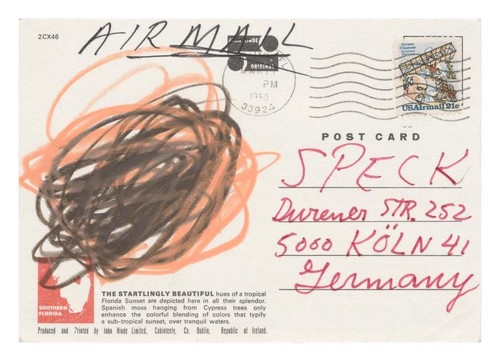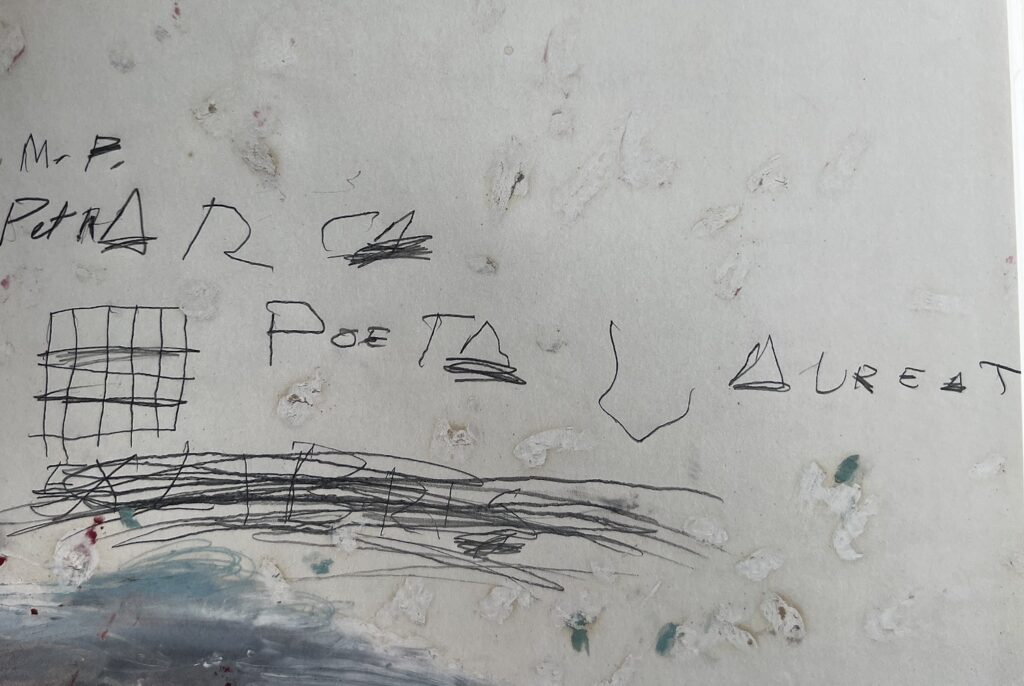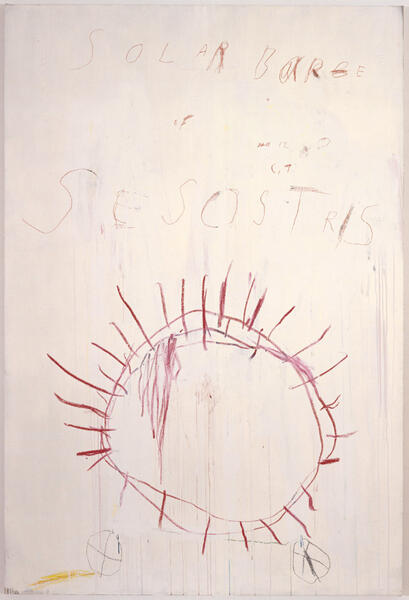
It’s the little differences. Where Marcel Duchamp’s letters to his collector friend Katherine Dreier are all, “shipping is $34, please send me $34,” Cy Twombly’s letters to his collector friend Reiner Speck are like, “we await you in the summer castle.” I have read the Twombly correspondence with noted urologist and Proust expert Herr Dr. Reiner Speck in the catalogue for Maison d’Art’s current exhibition, and here’s the expanded tl;dr:
thanks for the books; I was traveling; I am traveling; I will be traveling; I’m trying to work; I’m behind on work; Nicola had a great visit, thanks for taking care of him; come stay anytime, no need to call first; I owe you a painting; I am still working on your bookplate; also, heard “Proust was a yenta” and “a crypto cock sucker.”1

Alongside the artworks and the firsthand recollections of their making, these letters sometimes give insights of a shared, lived moment in art history. Like the seemingly relentless travel, but also the regularity of Twombly’s winter visits to Rauschenberg in Captiva, Florida, where tourist postcards found their way from his correspondence into his work, and where he heard the gay gossip about Proust. (Speck says he has the largest private Proust library in the world.)
Like how in April 1976, a few days shy of his 48th birthday, he writes [from Captiva] that he’s planning to move back to America: “Like an elephant, I’ll come home to die.” [He in fact did not move back for almost 20 years, and he did not die for another 35.]

How Twombly’s delta-shaped As, which I’d heard had specific ideographic meaning when writing Achilles’ name in Fifty Days at Iliam, kept turning up in Twombly’s work, in Adonis, Aphrodite, Petrarch, and Speck’s 3yo daughter Laura. Maybe he just thought it was neat.
And like how he signed his 1984/1985 holiday postcard with the name of his favorite pharaoh warrior barge captain: “Our Xmas dinner on the Nile, all dry + sand + much to see in LUXOR, Happy New Year to you all, SESOSTRIS.”

Overall, Speck’s 1960s and ’70s Twomblys seem a little more austere and less pictorial than the works in Twombly’s first big US museum show, at the ICA Philadelphia in 1975. But after seeing him sign letters as Sesostris, this quote from Heiner Bastian’s catalogue essay has me reseeing Twombly’s whole project through an auto-biographical lens:
The great landscapes of Arcadia, Twombly’s fantasies in his own Iliad, in the paintings of mythology. Gardens of the sea and land, water and rock, of light and darkness, dream and awakening: a seeking after the masks of identity. Great mirror- the masks as well of Pound’s Personae. Who speaks in Venus and Mars, Amor and Psyche, Leda and the Swan, Achilles and Patroclus, Achilles’ mourning and vengeance, in Io’s punished desires, in Orion’s blind fate, in Psyche, Diana. Flora, Theseus, Galatea’s triumph, Sesostris’ sun journey, in the madness of Aurelius Commodus, in Catullus, in Caesar’s Ides of March. Mirror of the masks, the conscious loss of identity- the actual seeking after one’s self!
Speck ends his account of the making of his portrait, in which Twombly reworked Speck’s responses to what he later realized was a sort of Proustian questionnaire: “Every portrait by an artist is always a self-portrait.” And every painting and postcard, too, apparently.
1 literally, that’s the whole note. Except for Twombly’s parenthetical, “(no matter, art solves everything).” Which Donald Ryan manages to read the most misdirected, homophobic interpretation imaginable of Twombly’s take on New York art world masculinity. Twenty years, almost to the day, and I cannot believe I’m arguing that “You cannot fully understand Twombly’s gossip unless you know that he is writing from his ex-boyfriend’s beach house, to a Proust superfan urologist, who sent him engravings of dickpics, and regularly hosted Twombly’s then-boyfriend in Germany, and is gay.”
